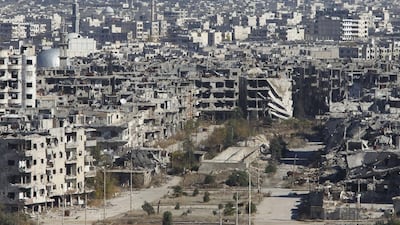BEIRUT // The number of foreign fighters in Syria and Iraq more than doubled to as many as 31,000 in the past year, new research said, as Syria’s fractured opposition gathered in Riyadh to forge common ground ahead of talks with the Syrian government.
Under a plan agreed upon by 17 countries in Vienna last month, representatives of Syrian president Bashar Al Assad’s government and the country’s opposition must begin negotiations toward a settlement of the conflict by January 1.
The negotiations are the first step in a timeline, which includes the formation of a transitional government within six months, elections and the creation of a new constitution within 18 months.
But before Syria’s opposition can sit down with the government they have been fighting for nearly five years, they must first decide who will represent them.
The goal of the three-day meeting is to find a unified message and appoint representatives of the moderate opposition to negotiate with the regime. But the inclusion of some groups and exclusion of others in the Riyadh meeting is already underscoring how difficult that could be.
While ISIL and Al Qaeda’s Syria branch Jabhat Al Nusra were excluded from talks for being terrorist organisations, other groups in attendance still remain divisive over extremist behaviour.
Included are Ahrar Al Sham, a deeply conservative militia whose now-deceased founder had ties to Al Qaeda and a group that continues to fight alongside Jabhat Al Nusra.
Jaysh Al Islam, a group that recently paraded caged Alawite men and women through a Damascus suburb, also sent representatives to Riyadh.
Kurdish groups — such as the Democratic Union Party (PYD), whose YPG military wing controls much of Syria’s border with Turkey and has proven to be the most effective fighting force against ISIL — were not invited.
Non-Kurdish members of the US-supplied Syrian Democratic Forces — a newly-formed alliance of Kurdish, Sunni Muslim, and Christian fighters — were also left out of the talks.
The Kurdish forces, who have avoided clashes with the government, are still viewed with suspicion by many Arab rebels. And Turkey, a major supporter of many Syrian rebel groups, stiffly opposes the rise of Kurdish power along its border, fearing that it will result in a Kurdish state and give a boost to Kurdish separatists at home.
Despite the friction and divisions, there is optimism that something will come out of the meeting.
“It is the first time there is a meeting in Saudi — a meeting of soldiers and politicians — and it has a greater chance of success because Saudi is hosting it,” said the head of one of the Free Syrian Army groups in attendance.
“Saudi is a pivotal state in the region and for it to take this step — to host a conference of the Syrian opposition factions — certainly something real will result from it.”
The latest talks hope to succeed where past meetings have failed to bring together Syria’s opposition forces.
“We did not take part before in conferences before, but we hope that this conference will be important for the future of Syria and ending the war,” said Abu Ghaith Al Shami of Alwiyat Seif Al Sham, which operates in southern Syria.
The talks got underway as an intelligence consultancy firm estimated that the number of foreign fighters in Syria and Iraq had doubled in the past year.
The Soufan Group warned on Tuesday that between 27,000 and 31,000 foreign fighters have travelled to Syria and Iraq to join ISIL and other extremist groups. A similar study by the group in June last year said there were 12,000 foreign fighters in those countries.
According to the report, about 16,000 foreign fighters come from the Middle East and North Africa, about 5,000 come from Europe and 4,700 from former Soviet republics.
The report warned that with an average 20 and 30 per cent of foreign fighters from western countries returning home, domestic security agencies face significant challenges.
Also on Tuesday, the US-led anti-ISIL coalition said it was investigating reports that one of its air strikes in Syria killed 26 civilians.
The UK-based Syrian Observatory for Human Rights said the deaths came from a coalition air strike on the village of Al Khan in north-eastern Syria’s Hassakeh province. Among the dead were seven children and four women. The group added that the death toll was likely to rise as more than a dozen people were still missing.
While ISIL controls Al Khan, their forces are only present on the outskirts of town and Monday’s air strike exclusively killed civilians, the group’s head Rami Abdel Rahman said.
The US-led coalition said it was “assessing the credibility” of the reports.
The potential mishap occurred just one day after coalition forces were accused by the Syrian government of bombing an army camp in Deir Ezzor, killing four Syrian soldiers.
The coalition denied striking Syrian government forces, with a spokesman saying the only strikes in the area were against an oil wellhead 55 kilometres south-east of the camp. A US official blamed Russian strikes for the deaths.
If the strike was carried out by the coalition, it would be the first time the coalition struck government forces in the conflict.
foreign.desk@thenational.ae
* with additional reporting from agencies

